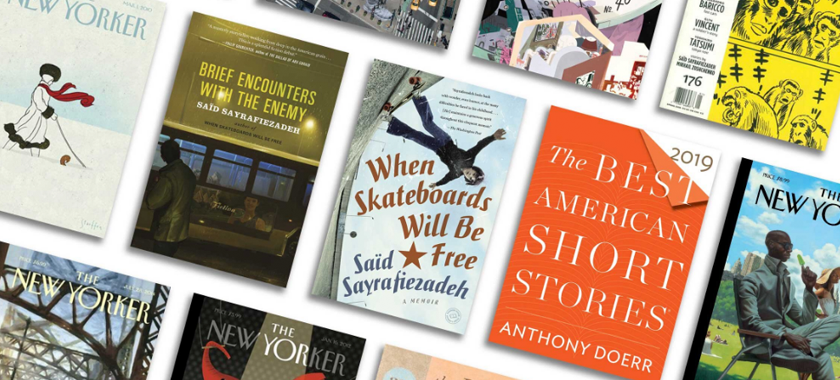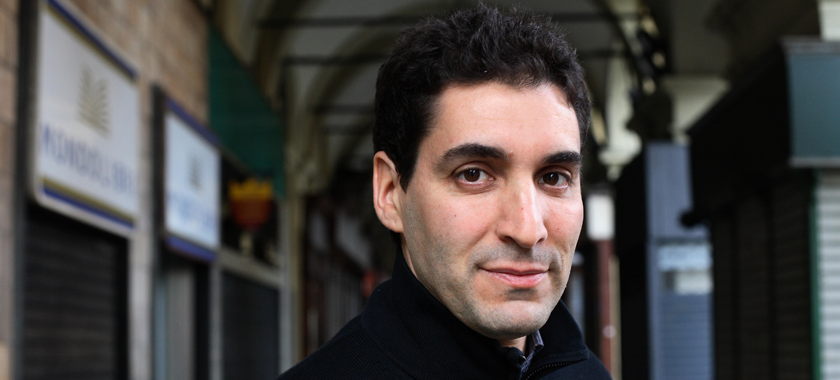Business of Art | How to Get Published and Find an Agent
NYFA Board Member Saïd Sayrafiezadeh, whose work has appeared in The New Yorker, The New York Times, and Granta, gives time-tested advice to emerging writers.
Though writing is a solitary act, the art of getting your work published is not. We recently spoke with NYFA Board Member Saïd Sayrafiezadeh (Fellow in Playwriting/Screenwriting, ’96, ’06; Fiction ’10), a memoirist, fiction writer, and playwright, to learn more about his career path as a writer; what he imparts to his students at Columbia University, Hunter College, and New York University about navigating the industry; and how to manage and set expectations for yourself and your work, especially when you are first starting out.
Sayrafiezadeh admits that his big break was a “one-off” that can be credited to a fellow basketball player whom he befriended on a West Village basketball court. The person was a writer with a small literary website, and was the first to publish Sayrafiezadeh’s work. It was through places like this that Sayrafiezadeh continued to publish and hone his work for the next few years before a Granta editor found his work and invited him to tell his story for publication. Once his work ran in Granta, he got an agent and wrote a proposal on how to turn the story into a book. The book, When Skateboards Will be Free, eventually sold to Random House—a step that enabled him to quit his long-time day job.
Sayrafiezadeh’s story shows the value of networking, and how some connections grow from less traditional networking spaces. “We are entrepreneurs. You’ve got to put yourself out there, you’ve got to be able to promote yourself,” says Sayrafiezadeh. And while writers can and do find success cold sending their work to editors, “it’s a real, real long-shot.” So how to leap frog over the slush pile and straight into the editor’s inbox? Meet other aspiring writers and attend events (whether in-person or online) with writers and editors and don’t be shy about approaching them. It takes practice and does not always come naturally; as such Sayrafiezadeh suggests that one way of easing the pressure of the experience is to think of it more as mingling and less as networking. “Maybe don’t think that you’re trying to actually jump-start your career,” he adds. Sayrafiezadeh encourages his students to attend at least one event per semester with a classmate, to ask questions at that event, and to introduce themselves to other people in the writing community. Afterwards, he suggests that they follow up by connecting with the people they meet on social media. Pro tip: when participating in online events, introduce yourself in the chat using your full name, relevant affiliations, and website and ask questions to stand out from the crowd.

While it is many a writer’s dream to land in the pages of The New Yorker, The Paris Review, Granta, and others, it’s helpful to set your sights slightly lower when you are first starting out. “This is not the time to be a snob, we all want to be in The New Yorker, but before you do that, go for smaller publications,” says Sayrafiezadeh. When you publish in smaller magazines and forums, it can lead to bigger opportunities.
For Sayrafiezadeh, putting time and energy into getting work published with smaller places and eventually getting published in Granta led him to working with an agent. If you’re wondering how to connect with one, consider that they want to see a full book (or proposal, if nonfiction) that they can sell. Agents like to see where you’ve published before (it’s ok if it’s small), any awards you’ve received, your background, and what your book idea is—you have to sell it to them! Placing your work in the context of similar contemporary books—not necessarily the best-sellers—will also help tell the story of what you can offer to the agent. Networking also plays a role here: having an “in” with a friend or another contact to mention in your introduction may help to get it directly in front of the agent. Sayrafiezadeh recommends familiarizing yourself with potential agent’s work before approaching them to make sure that you’d fit in their wheelhouse. On the question of how to find the right agent for you, think about work that is similar or complementary to yours, then search the acknowledgement pages at the back of the book. They’ll no doubt be named there.
If you face rejection with publishers or agents, don’t give up. “Rejection is par for the course. You just have to keep at it, it’s not a testament on your potential or your talent. Use the rejection as fuel for working harder and getting better,” says Sayrafiezadeh. Even as an established writer, Sayrafiezadeh acknowledges that he can always get better and that there is room for improvement. With every project, you learn something and you develop instincts that you can use in your career moving forward.
– Amy Aronoff, Senior Communications Officer
You can find more articles on arts career topics by visiting the Business of Art section of NYFA’s website. Sign up for NYFA News and receive artist resources and upcoming events straight to your inbox. Have an arts career question? You can contact NYFA staff directly by emailing [email protected].





